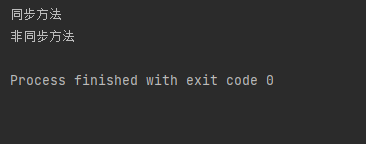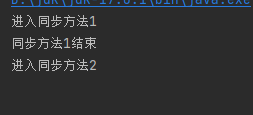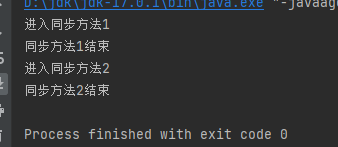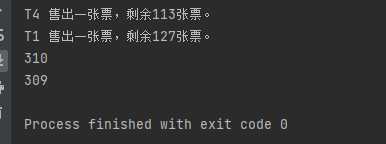您好,登錄后才能下訂單哦!
您好,登錄后才能下訂單哦!
這篇文章主要介紹了Java多線程面試題實例分析的相關知識,內容詳細易懂,操作簡單快捷,具有一定借鑒價值,相信大家閱讀完這篇Java多線程面試題實例分析文章都會有所收獲,下面我們一起來看看吧。
A線程正在執行一個對象中的同步方法,B線程是否可以同時執行同一個對象中的非同步方法?
可以,兩個線程運行所需資源不同,不需要搶占。
案例一、
package duoxiancheng2;
/**
* @author yeqv
* @program A2
* @Classname Ms1
* @Date 2022/2/7 19:08
* @Email w16638771062@163.com
*/
public class Ms1 {
//A線程正在執行一個對象中的同步方法,B線程是否可以同時執行同一個對象中的非同步方法?
Object a = new Object();
public static void main(String[] args) {
var t = new Ms1();
new Thread(() -> t.a1()).start();//A線程
new Thread(() -> t.a2()).start();//B線程
}
void a1() {
synchronized (a) {
System.out.println("同步方法");
}
}
void a2() {
System.out.println("非同步方法");
}
}運行結果:

同上,B線程是否可以同時執行同一個對象中的另一個同步方法?
不可以,兩個線程執行需要一個共同資源,共同資源加了同步鎖,同一時刻只能一個線程占用。
案例二、
package duoxiancheng2;
import java.util.concurrent.TimeUnit;
/**
* @author yeqv
* @program A2
* @Classname Ms2
* @Date 2022/2/7 19:25
* @Email w16638771062@163.com
*/
public class Ms2 {
//同上,B線程是否可以同時執行同一個對象中的另一個同步方法?
Object a = new Object();
public static void main(String[] args) {
var t = new Ms2();
new Thread(() -> t.a1()).start();//A線程
new Thread(() -> t.a2()).start();//B線程
}
void a1() {
synchronized (a) {
System.out.println("進入同步方法1");
try {
TimeUnit.SECONDS.sleep(10);
} catch (InterruptedException e) {
e.printStackTrace();
}
System.out.println("同步方法1結束");
}
}
void a2() {
synchronized (a) {
System.out.println("進入同步方法2");
try {
TimeUnit.SECONDS.sleep(10);
} catch (InterruptedException e) {
e.printStackTrace();
}
System.out.println("同步方法2結束");
}
}
}運行結果:
線程A先運行,占用資源。

等線程A運行完釋放資源后,線程B才可以進入執行

線程B執行完

線程拋出異常會釋放鎖嗎?
會,線程出現異常拋出后立刻釋放資源。
案例三、
package duoxiancheng2;
import java.util.concurrent.TimeUnit;
/**
* @author yeqv
* @program A2
* @Classname Ms3
* @Date 2022/2/7 19:41
* @Email w16638771062@163.com
*/
public class Ms3 {
//線程拋出異常會釋放鎖嗎?
Object a = new Object();
public static void main(String[] args) {
var t = new Ms3();
new Thread(() -> t.a1()).start();//A線程
new Thread(() -> t.a2()).start();//B線程
}
void a1() {
int c = 3;
int b;
synchronized (a) {
System.out.println("進入同步方法1");
try {
b = c / 0;
System.out.println(b);
TimeUnit.SECONDS.sleep(10);
} catch (InterruptedException e) {
e.printStackTrace();
}
System.out.println("同步方法1結束");
}
}
void a2() {
synchronized (a) {
System.out.println("進入同步方法2");
try {
TimeUnit.SECONDS.sleep(10);
} catch (InterruptedException e) {
e.printStackTrace();
}
System.out.println("同步方法2結束");
}
}
}結果: 方法一出現異常,立刻釋放資源。線程二開始執行

寫一個程序,證明AtomicInteger類比synchronized更高效
synchronized更高效
案例一
package duoxiancheng2;
import java.util.concurrent.atomic.AtomicInteger;
/**
* @author yeqv
* @program A2
* @Classname Ms4
* @Date 2022/2/7 20:04
* @Email w16638771062@163.com
*/
public class Ms4 {
AtomicInteger n = new AtomicInteger(10000);
int num = 10000;
public static void main(String[] args) {
var t = new Ms4();
new Thread(t::minus, "T1").start();
new Thread(t::minus, "T2").start();
new Thread(t::minus, "T3").start();
new Thread(t::minus, "T4").start();
new Thread(t::minus, "T5").start();
new Thread(t::minus, "T6").start();
new Thread(t::minus, "T7").start();
new Thread(t::minus, "T8").start();
}
void minus() {
var a = System.currentTimeMillis();
while (true) {
/* if (n.get() > 0) {
n.decrementAndGet();
System.out.printf("%s 售出一張票,剩余%d張票。 %n", Thread.currentThread().getName(), n.get());
} else {
break;
}*/
synchronized (this) {
if (num > 0) {
num--;
System.out.printf("%s 售出一張票,剩余%d張票。 %n", Thread.currentThread().getName(), num);
} else {
break;
}
}
}
var b = System.currentTimeMillis();
System.out.println(b - a);
}
}synchronized結果:

AtomicInteger結果:

寫一個程序證明AtomXXX類的多個方法并不構成原子性
package demo16;
import java.util.ArrayList;
import java.util.List;
import java.util.concurrent.atomic.AtomicInteger;
/**
* 寫一個程序證明AtomXXX類的多個方法并不構成原子性
*/
public class T {
AtomicInteger count = new AtomicInteger(0);
void m() {
for (int i = 0; i < 10000; i++) {
if (count.get() < 100 && count.get() >= 0) { //如果未加鎖,之間還會有其他線程插進來
count.incrementAndGet();
}
}
}
public static void main(String[] args) {
T t = new T();
List<Thread> threads = new ArrayList<>();
for (int i = 0; i < 10; i++) {
threads.add(new Thread(t::m, "thread" + i));
}
threads.forEach(Thread::start);
threads.forEach((o) -> {
try {
//join()方法阻塞調用此方法的線程,直到線程t完成,此線程再繼續。通常用于在main()主線程內,等待其它線程完成再結束main()主線程。
o.join(); //相當于在main線程中同步o線程,o執行完了,main線程才有執行的機會
} catch (InterruptedException e) {
e.printStackTrace();
}
});
System.out.println(t.count);
}
}寫一個程序,在main線程中啟動100個線程,100個線程完成后,主線程打印“完成”
package cn.thread;
import java.util.concurrent.CountDownLatch;
/**
* 寫一個程序,在main線程中啟動100個線程,100個線程完成后,主線程打印“完成”
*
* @author webrx [webrx@126.com]
* @version 1.0
* @since 16
*/
public class T12 {
public static void main(String[] args) {
CountDownLatch latch = new CountDownLatch(100);
for (int i = 0; i < 100; i++) {
new Thread(() -> {
String tn = Thread.currentThread().getName();
System.out.printf("%s : 開始執行...%n", tn);
System.out.printf("%s : 執行完成,程序結束。%n", tn);
latch.countDown();
}, "T" + i).start();
}
try {
latch.await();
} catch (InterruptedException e) {
e.printStackTrace();
}
System.out.println("---------------------------------------");
System.out.println("100個線程執行完了。");
String tn = Thread.currentThread().getName();
System.out.printf("%s : 執行完成,程序結束。%n", tn);
}
}關于“Java多線程面試題實例分析”這篇文章的內容就介紹到這里,感謝各位的閱讀!相信大家對“Java多線程面試題實例分析”知識都有一定的了解,大家如果還想學習更多知識,歡迎關注億速云行業資訊頻道。
免責聲明:本站發布的內容(圖片、視頻和文字)以原創、轉載和分享為主,文章觀點不代表本網站立場,如果涉及侵權請聯系站長郵箱:is@yisu.com進行舉報,并提供相關證據,一經查實,將立刻刪除涉嫌侵權內容。